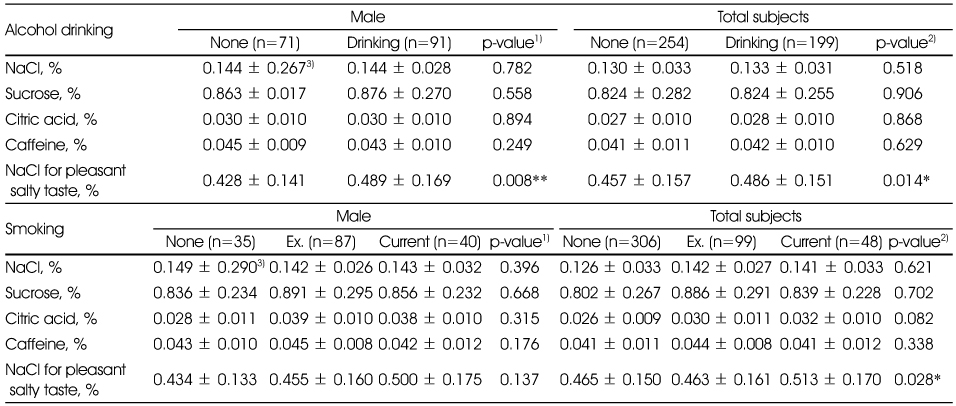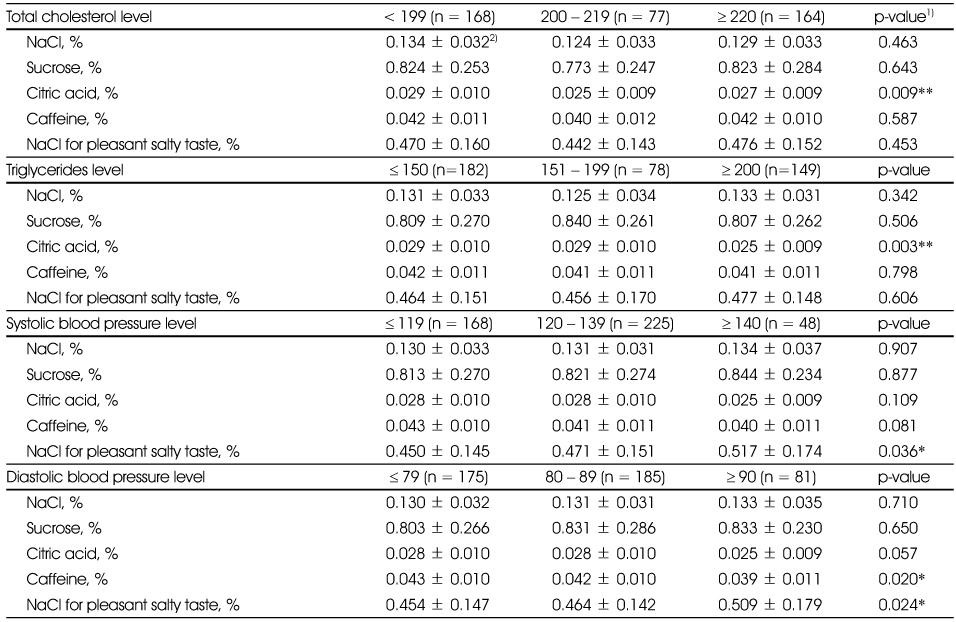References
1. Barylko-Pikielna N, Zawadzka L, Niegowska J, Cybulska I, Sznajderman M. Taste perception of sodium chloride in suprathreshold concentration related to essential hypertension. J Hypertens Suppl 1985. 33. S449–S452.
2. Chang SK, Kim YS, Lee SD, Suh SK, Yu SW. A study on optimal gustation of salt in hypertensive patients in Korea. Korean J Nutr 1983. 16(1)21–26.
3. Choi-Kwon S, Kim JS. Lifestyle factors and risk of stroke in Seoul, South Korea. J Stroke Cerebrovasc Dis 1998. 7(6)414–420.
4. de Jong N, Mulder I, de Graaf C, van Staveren WA. Impaired sensory functioning in elders: the relation with its potential determinants and nutritional intake. J Gerontol A Biol Sci Med Sci 1999. 54(8)B324–B331.
5. Fallis N, Lasangna L, Tetreault L. Gustatory thresholds in patients with hypertention. Nature 1962. 19674–75.
6. Grunberg NE, Morse DE. Cigarette smoking and food consumption in the United States. J Appl Soc Psychol 1984. 14310–317.
7. Henkin RI. Salt taste in patients with essential hypertension due to hyperaldosteronism. J Chronic Dis 1974. 27235–244.
8. Kampov-Polevoy AB, Garbutt JC, Janowsky DS. Association between preference for sweets and excessive alcohol intake: A review of animal and human studies. Alcohol Alcohol 1999. 34(3)386–395.
9. Kampov-Polevoy AB, Garbutt JC, Khalitov E. Family history of alcoholism and response to sweets. Alcohol Clin Exp Res 2003. 271743–1749.
10. Kim GH, Lee HM. Frequent consumption of certain fast foods may be associated with an enhanced preference for salt taste. J Hum Nutr Diet 2009. 22475–480.
11. Kim JH, Choi MK. Salt intake behavior and blood pressure: the effect of taste sensitivity and preference. J Korean Living Sci Assoc 2007. 16(4)837–848.
12. Kim KS, Paik HY. A comparative study on optimum gustation of salt and sodium intake in young and middle-aged Korean women. Korean J Nutr 1992. 25(1)32–41.
13. Kranzler HR, Sandstrom KA, Van Kirk J. Sweet taste preference as a risk factor for alcohol dependence. Am J Psychiatry 2001. 158(5)813–815.
14. Krut LH, Perrin MJ, Bronte-Stewart B. Taste perception in smokers and non-smokers. Br Med J 1961. 1(5223)384–387.
15. Lawson WB, Zeidler A, Rubenstein A. Taste detection and preferences in diabetics and their relatives. Psychosomatic Medicine 1979. 41(3)219–227.
16. Le AD, Li Z, Funk D, Shram M, Li TK, Shaham Y. Increased vulnerability to nicotine self-administration and relapse in alcohol-naive off spring of rats selectively bred for high alcohol intake. J Neurosci 2006. 261872–1879.
17. Lee MS. Taste perception of middle-aged and elderly people living in rural areas: relationships among threshold, taste preference and physical activity. Korean J Community Nutr 2010. 15(5)670–678.
18. Leshem M. Biobehavior of the human love of salt. Neurosci Biobehav Rev 2009. 331–17.
19. Massler M. Geriatric nutrition : the role of taste and smell in appetite. J Prosthet Dent 1980. 43(3)247–250.
20. Mattes RD. The taste for salt in humans. Am J Clin Nutr 1997. 652 Suppl. 692S–697S.
21. Mattes RD, Kumanyika SK, Halpen BP. Salt taste responsiveness and preference among normotensive, prehypertensive and hypertensive adults. Chem Senses 1983. 827–40.
22. McLaughlin B, Kevany J. A pilot investigation into the effect of a short-term restriction in sodium intake on blood pressure, sodium chloride taste threshold and the problems associated with such a dietary restriction. IJMS 1983. 152(11)399–403.
23. Ng K, Woo J, Kwan M, Sea M, Wang A, Lo R, Chan A, Henry CJK. Effect of age and disease on taste perception. J Pain Symptom Manage 2004. 28(1)28–34.
24. Nordin S, Bramerson A, Bringlov E, Kobal G, Hummel T, Bende M. Substance and tongue-region specific loss in basic tastequality identification in elderly adults. Eur Arch Otorhinolaryngol 2007. 264285–289.
25. Pepino MY, Mennella J. Effects of cigarette smoking and family history of alcoholism on sweet taste perception and food cravings in women. Alcohol Clin Exp Res 2007. 31(11)1891–1899.
26. Pomerleau CS, Garcia AW, Drewnowski A, Pomerleau OF. Sweet taste preference in women smokers: comparison with nonsmokers and effects of menstrual phase and nicotine abstinence. Pharmacol Biochem Behav 1991. 40995–999.
27. Pursell ED, Sanders RE, Haude RH. Sensitivity to sucrose in smokers and non-smokers: A comparison of TSD and percent correct measures. Percept Psychophys 1973. 1434–36.
28. Sato K, Endo S, Tomita H. Sensitivity of three loci on the tongue and soft palate to four basic tastes in smokers and nonsmokers. Acta Otolaryngol Suppl 2002. 54674–82.
29. Schechter PJ, Horwitz D, Henkin RI. Sodium chloride preference in essential hypertension. JAMA 1973. 2251311–1315.
30. Schelling JH, Tetreault L, Lasangna L, Davis M. Abnormal taste threshold in diabetes. Lancet 1965. 1508–512.
31. Schiffman SS. Taste and smell losses in normal aging and disease. JAMA 1997. 278(16)1357–1362.
32. Schiffman SS. Critical illness and changes in sensory perception. Proc Nutr Soc 2007. 66331–345.
33. Schiffman SS. Effects of aging on the human taste system. Ann NY Acad Sci 2009. 1170725–729.
34. Schiffman SS, Graham BG. Taste and smell perception affect appetite and immunity in the elderly. Eur J Clin Nutr 2000. 54Suppl 3. S54–S63.
35. Schumm LP, McClintock M, Williams S, Leitsch S, Lundstrom J, Hummel T, Lindau ST. Assessment of sensory function in the national social life, health, and aging project. J Gerontol B Psychol Sci Soc Sci 2009. 64Suppl 1. i76–i85.
36. van Wymelbeke V, Jiang T, Pfitzenmeyer P. Change in taste preference in undernourished elderly hospitalized subjects during periods of infection and convalescence. J Nutr Health Aging 2009. 13(1)40–45.
37. Vennemann MM, Hummel T, Berger K. The association between smoking and smell and taste impairment in the general population. J Neurol 2008. 2551121–1126.
38. Viskoper RJ, Lugassy G. Elevated taste threshold for salt in hypertensive subjects. Kidney Int 1979. 15582. (abstr).
39. Winkler S, Garg AK, Mekayarajjananonth T, Bakaeen LG, Khan E. Depressed taste and smell in geriatric patients. JADA 1999. 1301759–1765.
40. Zumkley H, Vetter H, Mandelkow T, Spieker C. Taste sensitivity for sodium chloride in hypertensive, normotensive and hypertensive subjects. Nephron 1987. 47(Suppl 1)132–134.




